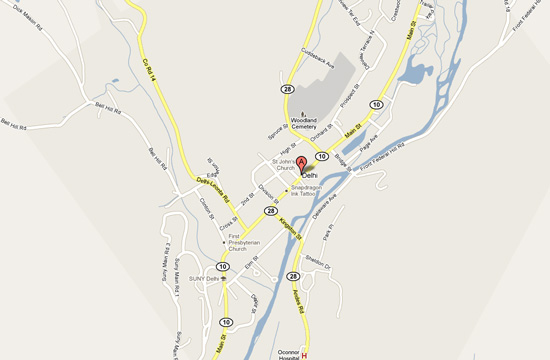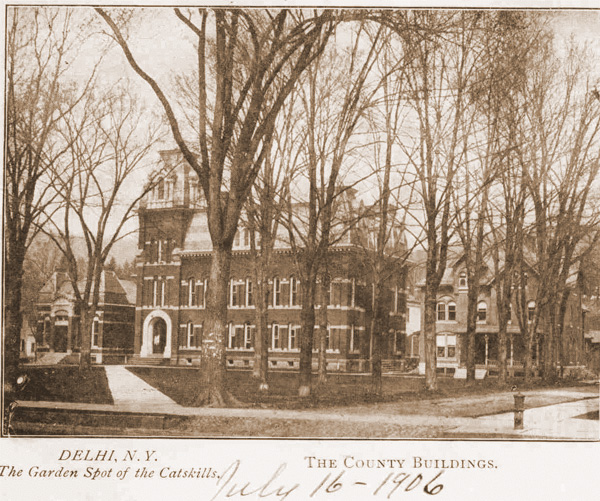The Geography
As described in Munsell’s 1880 History of Delaware County, N.Y., “The physical features of the town partake of the prevailing irregularity of hills and valleys, differing only from the towns down the river in that the hills are not so high, it being near the headwaters of the Delaware. The river runs nearly through the center of the town, giving the valley a wide stretch of rich alluvial soil. The Little Delaware, rising in Bovina, runs westerly into the river, forming its principal tributary, and provides, along its entire course, one of the most beautiful and fertile farming districts found in the county. To the north, Elk Creek, Falls Brook, Steele’s Brook, Peake’s Brook, and Platner’s Brook, with their branches, drain a succession of hills and valleys admirably adapted to grazing and farming. The town is well-watered with smaller brooks and numerous springs of soft water along every hillside. It contains about sixty square miles.”
Delaware County is located in what is known as the Southern Tier of New York State. As a matter of reference, Delaware County covers an area greater than the state of Rhode Island, has a population of roughly 48,000 (a population density of 48 persons per square mile), and does not have a federal highway running through it (although Interstate 88 crosses its boundary at several points along the northwestern edges of the county). It is only a 2 ½-hour drive from Manhattan.
Delhi is the county seat of Delaware County. Located in the geographic center of the county, Delhi lies at the junction of New York State highways 10 and 28, in the valley of the West Branch of the Delaware River. Delhi is surrounded by the small mountains and valleys indigenous to the Catskill foothills, in which dairy farms and pastures were nestled.
In relation to other metropolitan areas of New York State, Delhi is equidistant between Albany and Binghamton, on a line going northeast and southwest between the two, and equidistant between Syracuse and New York City, on a line going southeast and northwest between the two.
Delhi Over the Years
Delhi, being the county seat, naturally attracted an immediate population of lawyers, judges, and other professionals involved in legal, executive, and administrative fields. However, during the first century of the village’s existence, a significant industrial trade also developed. Along the waterways, grist mills and sawmills were established. Blacksmiths served the local residents by producing chains, cutting devices, and even leg irons. “In 1821 Mr. John Hunt came from Massachusetts … and took contracts for the building of the Episcopal and Presbyterian churches, and in 1825 for the digging of a canal and dam for the (woolen) mills now owned by Smith & Penfield.” (1880 History of Delaware County, N.Y.) (As recently as the 1950s, this body of water, known as the Mill Pond, still existed in the northeast quadrant of the village and served as an ice skating rink in the winter and a place for local boys to catch frogs, turtles, and other critters of the swamp.) The Mill Pond and dam became a focal point for small industries that required the power harnessed by the water flowing over the dam. At one time, a silk mill was located near this pond. A cooperage and a harness and carriage maker were situated at the lower end of what is now Elm Street in the village.
As the area developed, Delhi became home to many businesses that supported the village’s commerce. During its “heyday,” Delhi was home to no fewer than four multistory hotels, each offering not only lodging accommodations but also world-class dining and drinking establishments. These facilities were not the prototypical resort accommodations that developed in the lower Catskills during the early 20th century but true hostelries that served transient and commercial visitors to Delhi. The last grand Delhi hotel disappeared in the early 1950s.
The legal business of the county seat brought additional activity to Delhi. Of particular significance were the events surrounding the Anti-Rent Wars in Delaware County, which came to a climax on August 7, 1845, with the shooting death of Osman N. Steele, the undersheriff of Delaware County. An excellent documentary of these troubled times in Delaware County is provided in Dorothy Kubik’s A Free Soil—A Free People: The Anti-Rent War in Delaware County, New York, published by Purple Mountain Press in 1997. According to Kubik:
“By 1845, settlers had transformed the wilderness of the Catskills in upstate New York into productive farms. Their dream of owning their own land, however, became a nightmare as they tried to free themselves from the shackling leases of wealthy landlords. Considering their cause a continuation of the American Revolution, the tenants rebelled and refused to pay the rent. The more militant, like the colonists at the Boston Tea Party, called themselves ‘Indians.’ They dressed in grotesque disguises and appeared at sales of delinquent tenants’ property to intimidate bidders. Violence erupted at one of these sales near Andes in Delaware County, and a fatal bullet almost shattered their cause.”
The impact on Delhi, the county seat of Delaware County, was significant. During the trials of those involved in the shooting of Osman N. Steele, Delhi became almost like an armed camp, forced to defend itself from dissident fellow citizens from throughout the county. The building known as the second county courthouse, which is now the Village Hall (discussed in detail below), became the center of legal activity. Prisoners were housed in makeshift jails built from tents and logs located on what is now Courthouse Square, and legal proceedings continued for more than a year. During this time, the village of Delhi was held hostage to these activities. Eventually, the conflict was resolved, and Delhi returned to daily life, though the scars remain even today. (Note: A mural in the Delhi Post Office symbolically depicts the confrontation at Andes. The mural was painted in 1940, shortly after the post office was built, by an artist named Mary Early.)
Online references discussing various aspects of the Anti-Rent War may be found at:
As the Village of Delhi prospered, homes were built that epitomized the architectural trends of the times.

